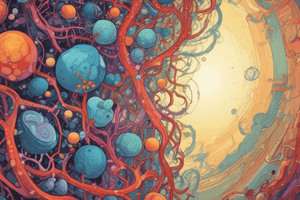Podcast
Questions and Answers
Who discovered cells?
Who discovered cells?
Robert Hooke
What does the word 'cellula' mean in Latin?
What does the word 'cellula' mean in Latin?
- Basic unit
- Life form
- Small room (correct)
- Building block
All organisms are composed of one or more cells.
All organisms are composed of one or more cells.
True (A)
Which of these are types of cells?
Which of these are types of cells?
What is a key characteristic of eukaryotic cells?
What is a key characteristic of eukaryotic cells?
What is the primary function of mitochondria?
What is the primary function of mitochondria?
Which of the following is NOT an organelle found in eukaryotic cells?
Which of the following is NOT an organelle found in eukaryotic cells?
A typical cell membrane is made up of a _________ bilayer.
A typical cell membrane is made up of a _________ bilayer.
What is cytoplasm?
What is cytoplasm?
Flashcards are hidden until you start studying
Study Notes
Overview of Cells
- All organisms are composed of cells, the basic unit of structure and function in life.
- The term 'cell' originates from the Latin 'cellula', meaning small room, first discovered by Robert Hooke in 1665.
- Cells facilitate chemical processes, converting biological molecules into energy and performing specialized functions.
- Contains hereditary material governing genetic characteristics.
Cell Theory
- Developed by Matthias Schleiden and Theodor Schwann.
- States:
- All organisms consist of one or more cells.
- Cells arise from pre-existing cells.
- Vital functions occur within cells, which contain hereditary information necessary for function and transmission across generations.
Types of Organisms
- Living organisms can be unicellular (e.g., bacteria) or multicellular (e.g., animals).
- Human body comprises approximately 30 to 40 trillion cells with specialized functions.
- Identical cells aggregate to form tissues, which organize into organs, creating organ systems.
Cell Types
-
Eukaryotic Cells:
- Feature a true nucleus with a nuclear membrane and well-defined chromosomes.
- Contain membrane-bound organelles (mitochondria, endoplasmic reticulum, Golgi bodies).
- Can be unicellular or multicellular; examples include plant and animal cells.
-
Prokaryotic Cells:
- Lack a distinct nucleus, with DNA not organized into chromosomes.
- Do not possess most membrane-bound organelles; primarily unicellular.
- Example: bacteria.
Structure of Eukaryotic Cells
- Comprised of two main components:
- Cell membrane
- Cytoplasm and organelles
Cell Membrane
- Thin, elastic, semi-permeable membrane approximately 7.5 to 10 nanometers thick.
- Composed of 55% proteins, 25% phospholipids, 13% cholesterol, 4% lipids, and 3% carbohydrates.
- Functions:
- Protects cell contents.
- Provides cell shape.
- Facilitates selective transport of substances.
- Aids in forming cell junctions.
Cytoplasm
- The jelly-like substance in eukaryotic cells surrounding the nucleus.
- Composed of 90% water and contains dissolved substances (minerals, sugars, amino acids).
- Serves as the site for key metabolic pathways, including glycolysis.
- Organelles within the cytoplasm vary in size and perform specialized functions.
Organelles
- Key organelles include:
- Mitochondria:
- Known as the "powerhouse of the cell"; generates energy (ATP).
- Structurally features a double membrane with inner folds (cristae) enhancing surface area for biochemical processes.
- Endoplasmic Reticulum
- Golgi Apparatus
- Ribosomes
- Lysosomes
- Peroxisomes
- Centrioles
- Vacuoles
- Nucleus
- Mitochondria:
Mitochondria Details
- Shape: Tiny, sausage-like structures (0.5 to 1 micrometer).
- Enclosed by a double membrane, facilitating energy production through oxidative enzymes.
- Impermeable to molecules/ions but allows diffusion of gases like carbon dioxide, oxygen, and water.
Studying That Suits You
Use AI to generate personalized quizzes and flashcards to suit your learning preferences.




